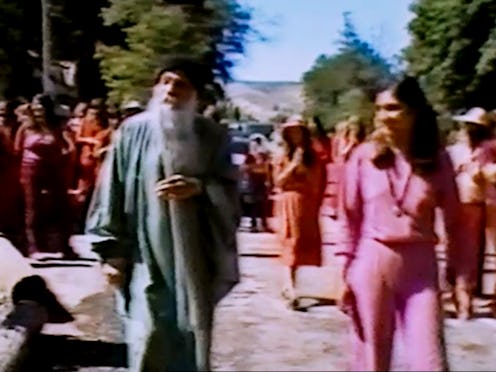Entertainment
You Can Actually Visit The Resort That Inspired This Bonkers Netflix Cult Docuseries

Describing the plot of the Netflix documentary Wild Wild Country isn't an easy or a quick business. The Oregon-based cult at the center of the series was involved in wiretapping, voter suppression, bioterrorism, free love, local ranchers, separation of church and state, as well as vintage car collecting, according to the doc. This chapter in history from the '70s and '80s has been largely forgotten, after what happened to Rajneeshpuram. But the group's beliefs still live on in some form.
"When we tell stories of cults," said Wild Wild Country executive producer Mark Duplass in the official Netflix press materials, "we tend to demonize them. But these people were smart, charismatic. They had great intentions. If I was alive around this time, I might have joined up with them. And that’s what’s special about what the [filmmakers] have done here — they’ve made a series in which all sides get a fair shake."
Ashrams like the one where Bhagwan Shree Rajneesh made his name are on the whole uncommon in India. The word simply means religious retreat, removed from modern society. According to the official Netflix press materials, the second episode of the series covers the Indian origin of Bhagwan Shree Rajneesh's American compound. That's where you learn about the original center of the guru's teachings. The synopsis reads:
"Tensions surrounding the expansion of Bhagwan’s ashram in Pune, India, lead the Rajneeshee to look for a new home. They settle on an expanse of arid land in Wasco County, Oregon, where members of the sect flock to establish a massive new city from scratch. Rajneeshpuram, though founded and built on Utopian, egalitarian ideals under the watchful eye of Sheela, creates enemies as it expands closer and closer to the tight-knit nearby community of Antelope."
Today, the former Rajneeshpuram in Oregon is known as Washington Family Ranch, a summer camp used by the wholesome Christian teen organization Young Life. Ironic, perhaps, for what was once home to a free love fringe group, but that's what became of the land. According to the Young Life website, "Canyon, a high school camp, opened in 1999, and Creekside, a middle school camp, opened in 2011."
The site also mentions Muddy Ranch, the name of the area before the Rajneeshees moved in. "Muddy Ranch consists of a farming and cattle operation as well as an outdoor program that includes guided fishing trips," it reads. "The Muddy Ranch team is currently working to bring the land back into production after many years of neglect and misuse. We're excited about what the Lord is currently doing on the ranch."
As for the Bhagwan's original ashram, it is still standing in India, with a few upgrades. You can still go to the resort — renamed Osho — and live by his teachings, signature red robes and all. You can visit Osho today, or at least visit their website. "Hello Friend," reads a pop up on the welcome page, "Ready to ignite your individual intelligence, achieve a healthy body-mind relationship and start living your full potential?" Another pop-up suggests that you might be interested in a residential program.
"Koregaon Park is bisected by a long tree-lined road in the center of Pune," wrote Noa Jones about her visit to the Osho International Meditation Resort in a piece for VICE in 2015, "a busy city three hours from Mumbai. The park is insulated by nature and protected by guards." In the piece, she describes the many activities and exercises she and a friend encountered during their short stay, sexual and otherwise.
Tempted to check it out? The rollercoaster that is Wild Wild Country should pique your interest at the very least. The fact that the original ashram is still operating in India likely explains why and how Oregon was able to close that door so effectively. Rajneeshpuram may be gone, but Osho lives on.